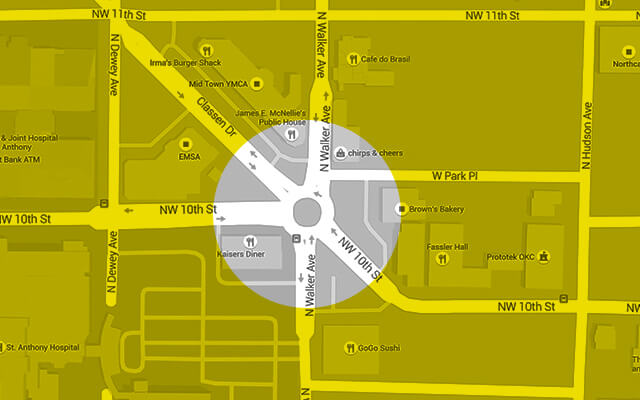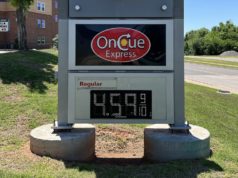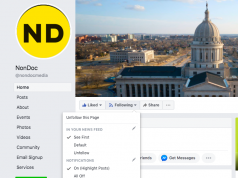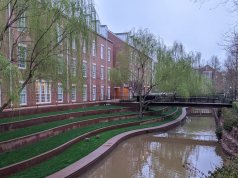
Nobody likes being stuck in traffic. Nobody likes sitting at a red light.
Josh McBee (managing editor here at NonDoc) taught me the term “punishment light,” which he learned while enduring the traffic of Los Angeles. Here in Oklahoma City, I have long threatened to run for mayor on a platform of Stoplight Reform.
Yet, despite all of our fair city’s punishment lights and ill-conceived turn arrows, Oklahoma City has one shining signal of traffic hope: roundabouts.
Unfortunately, too many drivers seem unsure of how to navigate roundabouts safely and efficiently. With only a handful of roundabouts in the state, drivers often approach roundabouts timidly and without confidence.
Here at NonDoc, we believe in the Common Good and all that, so let’s hop on a big yellow bus and head to Traffic School. We’ll even ask the questions for you:
‘What is a roundabout?’
A roundabout is a circle of roadway where two or more streets intersect. There can be many different sizes and types of roundabouts, but in general the idea is to move traffic from multiple streets in one direction around a circle. In America, traffic flows counterclockwise.
“I love them,” said Jerry Keith of Brown’s Driving School. I had called him out of the blue, and he was nice enough to grant an interview to a fledgling news website he’d never heard of.
“I think they’re fantastic if people know how to use them,” said Mr. Keith, who has been training young drivers for the past eight years. “You don’t have to stop, but everybody slows down in the most dangerous place there is — the intersection.”
‘How do I drive a roundabout without clogging traffic and feeling confused?’
Good news: Navigating roundabouts is pretty simple. Slow down at the roundabout and yield to traffic approaching from the left. Drive to the right around the circle until you reach the street of your destination.
“Don’t signal going in, but you signal when you get off,” Mr. Keith said. “We do not signal until we’re ready to exit, and it’s going to be a right-turn signal.”
‘Just where are you seeing all these roundabouts?’

The roundabouts I most encounter are the two in Midtown OKC along Northwest 10th Street, one of which connects three roads: Northwest 10th Street, Classen Drive and North Walker Avenue. Two others direct traffic within the Chesapeake Energy campus along Northwest 59th Street at Shartel Avenue and Classen Boulevard. To my knowledge — and to the knowledge of a 26-member Facebook Community called Oklahoma Roundabouts — those are the only four roundabouts in Oklahoma City.
In Tulsa, a two-lane roundabout connects the four-lane streets of East Admiral Place and North Mingo Road about a mile south of the Tulsa International Airport. Those multiple lanes make it, by my estimation, Oklahoma’s largest roundabout. (But it has nothing on roundabouts like this one in Spain.)
Another Tulsa roundabout sometimes moves traffic a little too quickly at East 11th Street and South Elgin Avenue, according to former journalist Spencer Gainey, who moonlights as a DJ. He knows a thing or two about spinning circles.
“The Elgin and 11th Street roundabout has seen some damage from drunk drivers,” Mr. Gainey said, adding that people need better roundabout education. “The turn is tighter than the (Admiral and Mingo) traffic circle and can be confusing.”
In Norman, planners created the city’s first roundabout in 2006 by connecting East Main Street with Carter Avenue and Acres Street, according to Norman City Councilman Stephen Tyler Holman.
“I’m a personal fan of roundabouts,” said Holman, who represents Ward 7 in the south part of Norman. “I believe they are more efficient at moving traffic and are more economical because they don’t require electricity to operate an intersection. So, at blackout or anything, they are still fully functional, and they don’t cost the electricity to operate a traffic signal all day.”
Holman pointed to fuel economy and lower gas emissions “adding up” over time to big savings.
Norman has constructed one additional roundabout within the University North Park development near I-35 and Rock Creek Road, and another roundabout will be constructed within the business park, Holman said. He added that proposals were floated to install roundabouts at multiple intersections along Lindsey Street between I-35 and Berry Road as part of the ongoing Lindsey reconstruction project, but efforts were rebuffed by some community leaders.
“It did open a door for how it might be very appropriate to do roundabouts on Lindsey between Berry (Road) and Jenkins (Avenue),” Holman said. “The biggest creator of congestion on Lindsey is between Berry and Jenkins with all those lights. (Roundabouts) might let traffic continuously flow. That could be something real you see happen, although I don’t know what the timeline would be.”
(Round) About the future
What many new urbanists — that’s literally a thing — would love to see is a continued focus on place-making and smart transportation in Oklahoma’s urban centers. A proposal for the new Crosstown Boulevard off of I-40 in downtown Oklahoma City to include a roundabout was not selected by planners, but other projects could support traffic circles in the future.
The ballyhooed Wheeler District in south Oklahoma City is one example of the development game shifting slightly away from suburban sprawl, though I don’t claim to know of their street plans. Meanwhile, the Urban Land Institute of Oklahoma has recently spurred discussions about how to make the six-lane Classen Boulevard more inclusive of pedestrians and bike traffic.
Will roundabout potential be studied for the awkward intersections where Classen and Western Avenue meet Northwest 18th Street and Northwest 13th Street? If you feel strongly one way or another, don’t forget to involve yourself in the public conversation.
Call your city councilor. Check out our list of public meeting notices. Write a letter to our Editorial Board. Just don’t forget to signal when you’re exiting a roundabout.





















